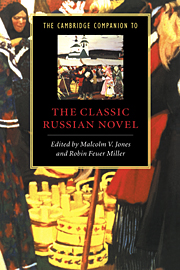10 - The Realist tradition
from Part 3 - The literary tradition
Published online by Cambridge University Press: 28 May 2006
Summary
Russian, like Western Realism, is best understood as a reaction against Romanticism, as an attempt, then, to reach out to topical mundane reality (Balzac's actualité), renouncing romantic fantasy or escape into an imaginary past and Sentimentalism's abstract discourses on virtue. Realism meant a concern with concrete Russian life, while Romanticism often pursued the exotic and Sentimentalism dealt with humanity in the abstract. In contrast to Romanticism's preoccupation with the extraordinary individual, Realism meant an interest in the concerns of ordinary men and women, in social problems and in the life of the lower classes. Also, Realism meant a faith in literature's calling to be involved in the affairs of real life.
The Russian realist novel, like the realist novel in the West, grew out of existing genres, while often using them as a foil. Gogol's Dead Souls (1842) is formally a picaresque novel. Dostoevskii's Poor Folk (1846) uses the sentimentalist form of the epistolary novel. His The Double (1846) is a “realized” version of a Gothic novel. Lermontov's A Hero of Our Time (1840) and Tolstoi's Cossacks (1863) “realize” the exotic novel made popular by Aleksandr Bestuzhev-Marlinskii in the 1830s.
- Type
- Chapter
- Information
- The Cambridge Companion to the Classic Russian Novel , pp. 190 - 209Publisher: Cambridge University PressPrint publication year: 1998
- 2
- Cited by



